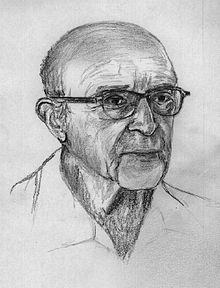
Back كارل روجرز Arabic كارل روجرز ARZ Carl Rogers AST Karl Rensom Rocers Azerbaijani کارل راجرز AZB Карл Роджерс Bashkir Карл Роджърс Bulgarian Carl Rogers Catalan Carl Rogers Czech Carl Ransom Rogers Welsh
Carl Rogers | |
|---|---|
 | |
| Born | January 8, 1902 Oak Park, Illinois, U.S. |
| Died | February 4, 1987 (aged 85) San Diego, California, U.S. |
| Alma mater | University of Wisconsin–Madison (BA) Union Theological Seminary Columbia University (MA, PhD) |
| Known for | The person-centered approach (e.g., Client-centered therapy, Student-centered learning, Rogerian argument) |
| Children | Natalie Rogers |
| Awards | Award for Distinguished Scientific Contributions to Psychology (1956, APA); Award for Distinguished Contributions to Applied Psychology as a Professional Practice (1972, APA); 1964 Humanist of the Year (American Humanist Association) |
| Scientific career | |
| Fields | Psychology |
| Institutions | Ohio State University University of Chicago University of Wisconsin–Madison Western Behavioral Sciences Institute Center for Studies of the Person |
Carl Ransom Rogers (January 8, 1902 – February 4, 1987) was an American psychologist who was one of the founders of humanistic psychology and was known especially for his person-centered psychotherapy. Rogers is widely considered one of the founding fathers of psychotherapy research and was honored for his research with the Award for Distinguished Scientific Contributions by the American Psychological Association (APA) in 1956.
The person-centered approach, Rogers's approach to understanding personality and human relationships, found wide application in various domains, such as psychotherapy and counseling (client-centered therapy), education (student-centered learning), organizations, and other group settings.[1] For his professional work he received the Award for Distinguished Professional Contributions to Psychology from the APA in 1972. In a study by Steven J. Haggbloom and colleagues using six criteria such as citations and recognition, Rogers was found to be the sixth most eminent psychologist of the 20th century and second, among clinical psychologists,[2] only to Sigmund Freud.[3] Based on a 1982 survey of 422 respondents of U.S. and Canadian psychologists, he was considered the most influential psychotherapist in history (Freud ranked third).[4]
- ^ Rogers, Carl (1942). Counseling and Psychotherapy: Newer Concepts in Practice. Boston, Massachusetts/New York: Houghton Mifflin. ISBN 978-1-4067-6087-3. OCLC 165705.
- ^ Haggbloom, Steven J.; Warnick, Renee; Warnick, Jason E.; Jones, Vinessa K.; Yarbrough, Gary L.; Russell, Tenea M.; Borecky, Chris M.; McGahhey, Reagan; Powell, John L. (March 2003). "'The 100 most eminent psychologists of the 20th century': Correction to Haggbloom et al (2002)". Review of General Psychology. 7 (1): 37. doi:10.1037/1089-2680.7.1.37. S2CID 151853298.
- ^ Haggbloom, S.J.; et al. (2002). "The 100 most eminent psychologists of the 20th century" (PDF). Review of General Psychology. 6 (2): 139–152. CiteSeerX 10.1.1.586.1913. doi:10.1037/1089-2680.6.2.139. S2CID 145668721. Archived (PDF) from the original on 2014-12-25. Haggbloom et al. combined three quantitative variables: citations in professional journals, citations in textbooks, and nominations in a survey given to members of the Association for Psychological Science, with three qualitative variables (converted to quantitative scores): National Academy of Sciences (NAS) membership, American Psychological Association (APA) President and/or recipient of the APA Distinguished Scientific Contributions Award, and surname used as an eponym. Then the list was rank ordered.
- ^ Smith, D. (1982). "Trends in counseling and psychotherapy". American Psychologist. 37 (7): 802–809. doi:10.1037/0003-066X.37.7.802. PMID 7137698.